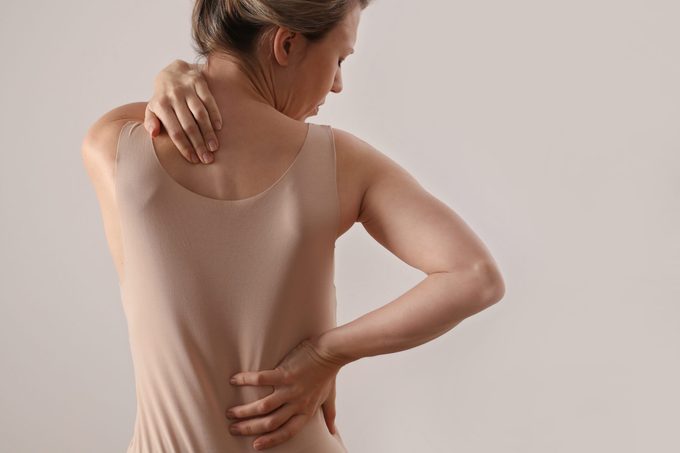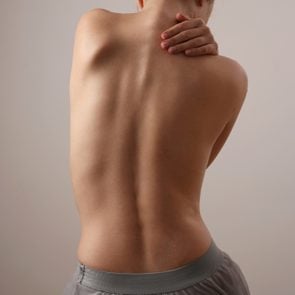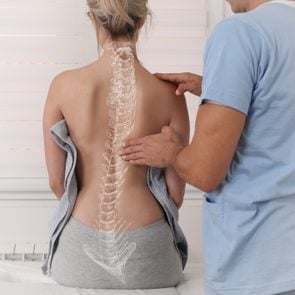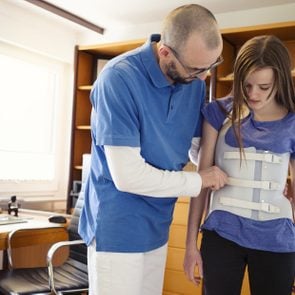20 Symptoms of Scoliosis in Kids and Adults
Updated: Mar. 11, 2022
Scoliosis symptoms are so subtle that they're easy to miss. These are the signs spine experts watch for when diagnosing scoliosis.
Understanding scoliosis
When viewed from the back, a straight spine would have zero degrees of curve. Yet most of us have some bend to one side or the other. The concern is when that curve exceeds 10 degrees, indicating scoliosis.
Scoliosis is predominantly found in children, but adults can have it too.
An abnormal spinal curve doesn’t necessarily interfere with everyday life or cause aches and back pain—at least for most people. But for some, there might be visible signs of scoliosis in higher degree curves or symptoms associated with some types of scoliosis.
Here are the signs and symptoms of scoliosis you should know about to determine whether you have scoliosis.
Types of scoliosis
Some forms of scoliosis induce different symptoms because they are associated with other conditions or diseases.
One bit of positive news: Mild to moderate scoliosis almost never necessitates prescription medication or surgery to treat the symptoms.
There are three categories into which the different forms of scoliosis fit:
Idiopathic: About 80 percent of scoliosis is classified as idiopathic. That’s the medical term that means a specific cause is not identified with a condition.
In case there is no defining cause of the spinal curvature. It affects infants, young children, adolescents, and adults.
Congenital: The least common form of scoliosis happens in one in 10,000 newborns.
The spinal deformities are present at birth as the result of improper vertebrae formation in the womb.
When the vertebrae don’t form correctly, it can affect the growth of other organs in the same area. Depending on the deformity, scoliosis could range from mild to life-threatening.
Neurological: Spinal curvature develops secondary to a neurological or muscular disease, such as muscular dystrophy, cerebral palsy, spina bifida, and spinal cord injury.
The nerves and muscles are incapable of maintaining proper balance/alignment of the spine and trunk.
Degrees of scoliosis
- Mild–10 to 25 degrees: Doctors may take a wait-and-watch approach.
- Moderate–25 to 45: The patient may require some form of bracing.
- Severe–45 degrees or more: Bracing and possibly surgery may be needed.
Visible signs of scoliosis
- one shoulder appears higher than the other
- one shoulder blade is more prominent than the other
- the head isn’t centered over the rest of the body
- when standing up straight, one arm is longer than the other
- one hip is higher or more prominent than the other hip
- when bending forward, the back looks lopsided
Most cases of scoliosis conditions are asymptomatic—people don’t really experience symptoms, though the curve may be visible.
The spine can curve in different ways, so the symptoms relating to curves vary from person to person.
Some curves slant to the left or right and look like the letter “C.” Others may zig-zag in both directions and resemble an “S.” A curvy spine might not even be noticeable in some.
If the curvature is larger, it might show more obvious signs on the body.
“Thoracic scoliosis (in the chest) can make a rib prominence or make a scapula (wing bone) prominent,” says John M. Flynn, MD, a pediatric orthopedic surgeon and chief of the division of orthopedics at Children’s Hospital of Philadelphia.
“Lumbar scoliosis (low back) makes the trunk shift/hip asymmetry,” he adds.
Those with moderate scoliosis (25-70 degrees) can usually sense or see these physical signs:
Less common scoliosis symptoms
- pressure on vital organs
- pain
- lung infections
- difficulty sitting
- digestive issues
It’s exceptionally rare, but the spinal curvature could place pressure on vital organs such as the lung and heart and cause shortness of breath.
This can happen when the curvature is severe and at any age. When a child is still growing, it could interfere with the growth and development of the lungs.
“If severe it can compromise breathing ability as the patient grows,” says Sumeet Garg, MD, a pediatric orthopedic and spine surgeon and associate professor of orthopedics at the University of Colorado.
“As a rule, children and adults with mild to moderate scoliosis have no more back pain than children and adults without scoliosis,” adds Joseph Davey, MD, chief of pediatric orthopedics at the University of Oklahoma.
Still, mild discomfort or pain in the back might materialize for some people in certain circumstances.
Children with neuromuscular scoliosis might have pain while seated, and people with degenerative scoliosis could feel back pain when they are walking or standing.
Pinched nerves, improper balance, underlying diseases, and conditions associated with scoliosis could trigger pain.
Additionally, severe curves or those associated with spinal cord abnormalities may also cause neck pain, back pain, and headaches.
When the curvature is less than 25 degrees, there aren’t many health concerns. However, if the curve increases, worrisome symptoms could materialize.
“As curves enlarge, this may affect the ease of sitting, the chance of getting lung infections, or overall gastrointestinal function,” Dr. Davey.
Symptoms of scoliosis in adults
Adult scoliosis falls into two groups, adult idiopathic scoliosis and adult degenerative scoliosis.
Adult idiopathic scoliosis
- leg pain
- weakness
- tingling
The adult version of scoliosis can be a continuation of the adolescent-idiopathic type or previously untreated adolescent scoliosis.
In comparison, “adult degenerative scoliosis encompasses patients who did not have a spinal curve as adolescents but developed scoliosis as they age due to degenerative changes in adulthood,” says Shahbaaz A. Sabri, MD, orthopedic surgeon at UCHealth Broomfield Medical Center and assistant professor at University of Colorado School of Medicine.
“These curves are generally seen in the lumbar spine,” he says. Often, the patient’s symptoms are more likely due to an aging spine, being overweight, or wrenching their back from lifting something too heavy than idiopathic scoliosis.

Degenerative scoliosis
- Stiffness and pain in the lower back
- Numbness, cramping, or shooting pain in the legs from the pinched nerves in aging discs
- Fatigue from back and muscle strain
- Poor posture
- Difficulty walking, moving about in daily activities
- Height loss
Degenerative scoliosis is the most common form of adult scoliosis, occurring in about 38 percent of adults.
It’s more prevalent in women and people over 60 years of age. This type of scoliosis can develop as the aging spine naturally begins to curve.
“Degeneration of the intervertebral disks (degenerative disc disease) plays a major role in the structural collapse and development of degenerative scoliosis,” says Robert K. Eastlack, MD, orthopedist, Scripps Memorial Hospital, Scripps Green Hospital, and Scripps Mercy Hospital, La Jolla, California
Surprisingly, the actual curves in degenerative scoliosis are seldom the culprit for back pain in older adults.
“Even in adulthood with degenerative changes or degenerative scoliosis, there is not a substantially greater likelihood of pain generation than found in the nonscoliotic general population,” says Dr. Eastlack.
If degenerative scoliosis is symptomatic, it’s probably associated with aging discs or arthritis.
“Additionally, a patient’s ability to maintain an upright posture may decompensate with time, leading to increased pain and decreased ability to ambulate (move about),” Dr. Sabri explains.
“Depending on the severity of the deformity and degeneration, these symptoms range from mild or moderate to potentially debilitating,” he says.
(Check out the best mattresses for scoliosis that give your spine extra support.)
Diagnosing scoliosis
The signs of scoliosis on the back can be very subtle, that curvature can go undetected, especially in children.
“One of the key things to understand about scoliosis in children is that there are no symptoms. That is why pediatricians and even school nurses have been charged with screening children for scoliosis,” explains Dr. Flynn.
It’s easy to miss scoliosis when clothes cover abnormalities. Parents might notice an abnormality while bathing their child. Or parents might notice their pre-teen’s back looks a bit crooked while they’re in a swimsuit.
Once scoliosis is noticed by a parent or doctor during a routine checkup, the next step is visiting an orthopedic doctor.
Diagnosis is confirmed via a head-to-toe 360-degree visual, physical examination, an x-ray, spinal radiograph, CT scan, or MRI.
The curve is measured by the Cobb Method and is diagnosed in terms of severity by the number of degrees.
Any cure that measures more than 10 degrees is defined as scoliosis, but curves aren’t considered significant unless they are more than 25 to 30 degrees.
Curves that fall into the 45 to 50 degrees are deemed severe and often require more aggressive treatment.
Scoliosis treatments
The vast majority of scoliosis cases won’t require treatment. As a matter of fact, according to the National Scoliosis Foundation, four out of five people have a curvature of 20 degrees or less.
With this diagnosis, observation via doctor visits every six to 12 months to see if the curve is increasing.
Treatment for more severe types is tailored to the individual—it really depends on the age, skeletal maturity, and degree of curvature.
Bracing
For children with higher degrees of curvature, bracing might be prescribed to slow or halt the progression of the curve while their bones are still growing.
Bracing isn’t an option for adults because their bones have reached skeletal maturity. Though people may wear non-prescription type braces for comfort or to soothe pain while sitting or performing daily activities.
OTC meds
Back pain is typically mild and treated with over-the-counter nonsteroidal anti-inflammatory drugs (NSAIDs) such as ibuprofen or naproxen, or home remedies for pain.
Physical therapy
Physical therapy, stretching, yoga, massage, and chiropractic care can be helpful to keep back and core muscles strong, flexible and possibly reduce back pain, if present.
It’s important to note that these methods don’t correct curvature.
It’s seldom necessary, but surgery may be necessary to correct progressive curvatures that aren’t remedied by NSAIDs, bracing and physical therapy.
Surgery
The type of surgery depends on the specific scoliosis condition.
By far, a procedure called spinal fusion is performed the most. It’s the gold standard to realign the spine and prevent further curvature.
Simply put, the surgeon fuses two or more vertebrae so that they heal into a single, solid bone.
Recovery is expected within one to three months, contingent on age and overall health.



